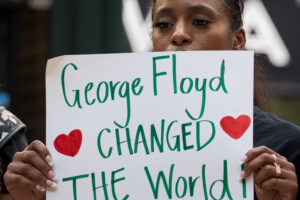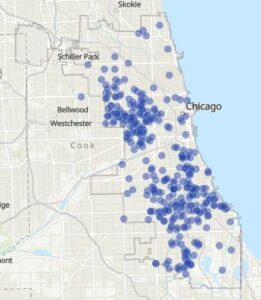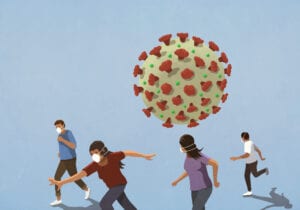There is comfort to be found in self-delusion, especially when your delusion is shared among so many of your friends and admirers. Consider Lori Lightfoot, mayor of Chicago, the gutters of which are awash with the blood of shooting victims. As of this writing, 2,386 people have been shot and 434 murdered this year in the city, an average of twelve shooting victims and two murder victims every day.
The violence is for the most part is confined to neighborhoods on Chicago’s South and West Sides, but even residents in neighborhoods once considered safe are now dodging bullets. On Wednesday night, eight people were wounded when gunmen shot up a party bus in the Old Town Triangle neighborhood near Lincoln Park. It was the city’s third shooting with at least five victims in a six-hour period. A 15-year-old boy was killed in one of them. Thirteen more people were shot on Thursday, one of them fatally.

That he did.
Mayor Lightfoot consoles herself with the fantasy that this daily display of violence can be attributed to the Covid pandemic, which she claims has impinged on the criminal courts’ ability to keep lawbreakers in check. Anyone who doesn’t share the mayor’s desperation to believe this nonsense should read the refutation of the claim by the Chicago Sun-Times.
Like so many others in politics, academia, and the media, Mayor Lightfoot entertains this fantasy because she cannot publicly admit the uncomfortable truth about crime, which is that there are neighborhoods in Chicago, as there are in every large American city, where the only restraint on criminal predation is the presence of police officers able and willing to intervene in it.

Murder City.
For the past several years, most especially since the death of George Floyd last year, the American left, to include Mayor Lightfoot, has busied itself delegitimizing the police, portraying them as contributors to, not solvers of crime. This has motivated veteran officers to retire earlier than they might have, younger ones to leave the profession, and left those who remain on the job so dispirited as to be reluctant to engage in the type of proactive police work proven to reduce crime.
Consider the map above, taken from the Chicago Tribune’s website, on which each of this year’s murder victim is represented by a blue dot. The map resembles nothing so much as a petri dish choked with poisonous spores, with more being added every day. Viewed in this way, it’s easy to see the city’s murder problem as an abstraction, especially if one lives in a neighborhood where the dots are few or absent altogether. Putting aside any demographic patterns that might be inferred from the arrangement of the dots, suffice it to say that those neighborhoods where they are most heavily concentrated are those where the city’s social and moral fabric are most conspicuously frayed, and where effective police work should be most readily welcomed and encouraged.
Each of those dots represents someone who, until he was struck down (in most cases by gunfire) was going about his business with no idea what was about to befall him. And, almost as important as the lives taken, each of those dots is like a pebble plunked in a pond, with the ripples of anguish and sadness radiating out to the dozens of people who knew the victim and the thousands of others who every day live with the sound of gunshots and the specter of bloodstained sidewalks and fluttering strands of crime-scene tape in their neighborhoods.
For every shooting victim there is of course at least one shooter, someone who woke up in the morning and had his breakfast before venturing out carrying the gun he would use to deadly effect later on. He was unafraid of carrying that gun because he had, perhaps deliberately, perhaps inchoately, calculated the risks of doing so and found them acceptable.
They are acceptable to him because many if not most of the cops who patrol his neighborhood have similarly calculated the risks of stopping him and found them prohibitive. A good cop working any neighborhood comes to discern the good people from the bad, the pilgrims from the predators, if you will, the latter of whom can be divided into the dope dealers, the burglars, the robbers, and the shooters. And even when observing people he doesn’t recognize, the good cop can detect, through subtle cues in body language, those who are likely to be carrying a gun.
When he sees such a person the cop has a choice to make. He can pretend he hasn’t seen what he sees and drive on, or he can try to stop the man. The cop knows that if he tries to make the stop it can turn out in only a few ways, the first and least likely of which is that the man will put up his hands and say, “You got me, officer. I’ve got a gun, take me to jail.”
Failing this, the man may run and try to ditch the gun on the fly, or he may hold on to it while he flees, hoping to reach a safe place before the cop can catch up to him. Or – and this is where the risk assessment comes into play – the man may try to fight with or even shoot the officer in an effort to escape.

Is there anything it can't do?
If he is both skilled and lucky, the cop will win the fight or shoot before being shot. But even if he comes through physically unscathed he very likely will be thrust into a multi-year legal ordeal during which he, the cop, will be portrayed as a villain while the man he has vanquished, no matter how lengthy his rap sheet, no matter how contemptible his past, will be canonized into the litany of secular saints and remembered as “kind” and “generous” despite all evidence to the contrary, and who will be described as a “good father” when in most cases it would be more accurate to say he was merely a prolific one.
This is the world of Chicago’s cops, and of those in most other cities in the country. Until that changes, until politicians like Lori Lightfoot can admit the truth about what ails their cities, the bodies will continue to stack up in the morgues. In the meantime, Lightfoot and her ilk will cling to the belief that it is the pandemic that is responsible for all their cities’ woes, and that all will be well if we can just get enough people vaccinated.
Yes, there is a perverse comfort in self-delusion. Alas, there is no vaccine for it.
Article tags: BLM, Chicago, Covid-19, Lori Lightfoot, police
It is now clear that we will be locked in by a permanent state of emergency, covered up by filthy masks and held down by regime goons and injected with this, that or the other thing unless we rise up and depose these people. Our new masters in Beijing, the globalist Bond villains in Davos and and Seattle and the elites in Chicago, Washington and elsewhere are not going to be locked down. For the Inner Party it will be every night at the French Laundry, with the regular people picking up the tab. It is time to get the Second American Revolution and if necessary the Second Civil War over with, and begin the construction of a Second Republic, in the hope that we will be able to keep this one.